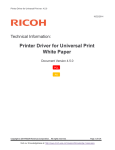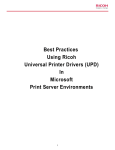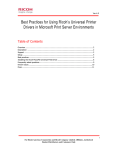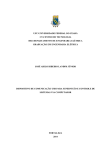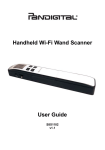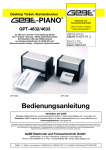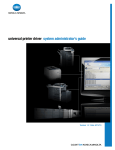Download Ricoh Type W3600 Technical information
Transcript
PS Driver for Universal Print 4.3.0 4/10/2014 Technical Information: PS Driver for Universal Print White Paper Document Version 4.3.0 Copyright © 2014 RICOH Americas Corporation. All rights reserved. Page 1 of 63 Visit our Knowledgebase at: http://www.ricoh-usa.com/support/knowledge_base.aspx PS Driver for Universal Print v4.3.0 NOTICE: This document may not be reproduced or distributed in whole or in part, for any purpose or in any fashion without the prior written consent of Ricoh Company limited. Ricoh Company limited retains the sole discretion to grant or deny consent to any person or party. Copyright © 2013 by Ricoh Company Ltd. All product names or product illustrations, including desktop images, used in this document are trademarks, registered trademarks or the property of their respective companies. They are used throughout this book in an informational or editorial fashion only. Ricoh Company, Ltd. Does not grant or intend to grant hereby any right to such trademarks or property to any third parties. The use of any trade name or web site is not intended to convey endorsement or any other affiliation with Ricoh products. The content of this document, and the appearance, features and specifications of Ricoh products are subject to change from time to time without notice. While care has been taken to ensure the accuracy of this information, Ricoh makes no representation or warranties about the accuracy, completeness or adequacy of the information contained herein, and shall not be liable for any errors or omissions in these materials. The only warranties for Ricoh products and services are as set forth in the express warranty statements accompanying them. Nothing herein shall be construed as constituting an additional warranty. Ricoh does not provide legal, accounting or auditing advice, or represent or warrant that our products or services will ensure that you are in compliance with any law. Customer is responsible for making the final selection of solution and technical architectures, and for ensuring its own compliance with various laws such as the Gramm-Leach-Bliley Act, the Sarbanes-Oxley Act and the Health Insurance Portability and Accountability Act (HIPAA). Page 2 of 63 PS Driver for Universal Print v4.3.0 Version History: Version Issue Date 1.0.0 Feb. 18, 2009 1.1.0 Mar. 30, 2009 1.2.0 June 16, 2009 1.3.0 Aug. 17, 2009 1.4.0 Nov.13, 2009 1.5.0 Feb. 19, 2010 1.6.0 May 19 2010 1.7.0 Sep. 13 , 2010 , th Revisions Initial release Added ports to the “Supported Ports > Specifications” section. Added “User Interface” to the “Specifications” section. Added models to the “Models > Specifications” section. Added “Notes” section. Added models to the “Models > Specifications” section. Added a “Note” to the “Supported Ports > Specifications” section. (The functionality described in the note has been supported since PS driver for Universal Print v1.00.00 but was not clearly stated in former versions of this document.) Added information about the effect of “Bi-directional communication” on tray status. (The information added is not new. It has been part of the PS driver for Universal Print specification since v1.00.00. However, it was not clearly stated in former versions of this document.) Renamed “Models” section to “Supported Models”. Added models to the “Supported Models > Specifications” section. Deleted “Aficio MP 1500” from the “Supported Models > Specifications” section. Added Windows 7/2008 R2 to the “> Supported Operating Systems > Specifications” section. Added PrinterSwitcher Port to the “Supported Ports > Specification” section. Added models to the “Supported Models > Specifications” section. Added “Generic Model” section. Added “PrinterSwitcher” section. Added supported models to the “Supported Models > Specifications” section. Added supported models to the “Generic Model” section. The PS Driver for Universal Print version is now v.3.20.00. (No new functions or supported models have been added. Added Aficio SP C430DN/C431DN to the “Supported Models > Specifications” section. Added Aficio SP C430DN/C431DN to the “Generic Model” section. Modified the “Upgrading the driver” procedure. Modified the “Upgrading the driver” section. Added “Uninstalling the driver” section. Added “Disabling bi-directional communication” section. Added “Economy Color” section. Page 3 of 63 PS Driver for Universal Print v4.3.0 Version Issue Date 2.0.0 Mar. 30 , 2011 th Revisions This document has been reclassified a “White Paper” instead of a “Technical Information document”. The PS Driver for Universal Print version is now ver.3.5.0.0. Added the following models as being fully supported or supported as “Generic model”: - Aficio MP W2401/W3601, Aficio MP C4501, - Aficio MP C5501, Aficio MP C4501A, - Aficio MP C5501A, Aficio MP C3001, - Aficio MP C350, Aficio MP C300, - Aficio MP C300SR, Aficio MP C400, - Aficio MP C400SR, Aficio MP C2051, - Aficio MP C2551, Aficio SP C320DN Added a “Scripting” section. Added a “Point and Print” installation procedure. Added a “Web Point and Print” installation procedure. Added a “Plug and Play” installation procedure. Added a reference to iPrint documentation. Explained that the use of the PS DRIVER FOR UNIVERSAL PRINT with a server cluster is supported. Explained that “Printer Driver Isolation” is supported. Added information about the change in terminology for the setting “Print Mode > Economy Color”. - Added Aficio MP 201 to the “Supported Models > Specifications” section. 2.1.0 June 14th, 2011 - Added Aficio MP 201 to the “Generic Model” section. - Added information about the way the driver retrieves an SNMP community name from a Novell iPrint server. - General corrections throughout. - Remove Windows 2000 from support OS - Added information about “Microsoft Cluster Service and Failover Cluster”. - Added the information about Citrix environment. − 2.2.0 nd Sep 22 , 2011 Added some models to the “Supported Models. Added some models to the “Generic Model” section. − Added information about “GUI based remote installation and queue creation”. − Added information for the Package Awareness to the point and print section. − Added a “Printer Driver Editor” overview section Added a “Printer Driver Editor” specifications section Page 4 of 63 PS Driver for Universal Print v4.3.0 Version 2.3.0 Issue Date th Oct 5 , 2012 Revisions - Support for the following models: - Aficio SP C830DN/C831DN - Aficio SP 8300DN - Added support for the following models: - MP 2001/2501 - Aficio SP C730DN 2.4.0 Feb 1st, 2013 - Added support for Windows 8 and Windows Server 2012 to the “Supported Operating Systems > Specifications” section. - Added information about Server Core. - Deleted the Plug and Play installation procedure. - Removed support for Citrix Presentation Server 4. 4.0.0 June 29, 2013 -The PS Driver for Universal Print version is now v4.0.0. - Added support for the following models: - MP 2553/3053/3353 4.1.0 Sep. 27, 2013 - Pro 8100S/8110S/8120S - Added newly supported languages to the “Supported Languages” in OVERVIEW section. - Added support for the following models: - MP 2003/2503 4.2.0 Dec. 22, 2013 - Added newly supported operating systems to each regarding section. - Added newly supported features to "Other Important Points" section. ‒ Added support for the following models: ‒ MP C401/C401SR ‒ Added “Japanese” to the “Supported Languages” section. ‒ Added details about New Driver button support for do-it-yourself customized drivers to the “Do-It-Yourself 4.3.0 Mar. 20, 2014 Driver Customization” section. ‒ Added supported driver versions to the “Printer Driver Packager NX” section. ‒ Added details about the “Gray Reproduction” setting to the “Gray Reproduction” section. ‒ Added details about “Save Driver Settings” to the “Save Driver Settings” section. Page 5 of 63 PS Driver for Universal Print v4.3.0 TARGET READERS: 1. All end users - The information contained in the document can be distributed to end users as long as you follow the restrictions outlined on page 2. The main target readers are IT Administrators. When distributing this document to end users, region specific information including model names must be modified. NDA is not required to disclose the contents of the document to the customers. 2. The regional support and marketing staff of each regional company 3. The support and marketing staff of Ricoh Sales companies including Ricoh family group companies and their subsidiaries. 4. Technical support personnel (CEs) of dealers. Page 6 of 63 PS Driver for Universal Print v4.3.0 TABLE OF CONTENTS: Overview ............................................................................................................................ 9 What is the Universal Driver? .................................................................................................. 9 Advantages of the Universal Driver ....................................................................................... 10 Supported Operating Systems............................................................................................... 11 Supported Printing Methods .................................................................................................. 12 Microsoft Cluster Service and Failover Cluster ...................................................................... 12 Server Core Environments .................................................................................................... 12 Novell .................................................................................................................................... 12 Citrix Environment ................................................................................................................. 13 Supported Models ................................................................................................................. 17 Model-Specific ....................................................................................................................... 17 Generic Model ....................................................................................................................... 17 Supported Models (PS Driver for Universal Print v4.3.0.0) .................................................... 17 Supported Languages ........................................................................................................... 19 CERTIFICATION SUPPORT ............................................................................................. 20 WHQL and Microsoft Server Catalog ..................................................................................... 20 The PS Driver for Universal Print is certified by Microsoft Windows:...................................... 20 Citrix Ready........................................................................................................................... 20 SUPPORTED WINDOWS ARCHITECTURE .................................................................... 21 Printer Driver Isolation Support.............................................................................................. 21 Package Awareness .............................................................................................................. 21 Do-It-Yourself Driver Customization .............................................................................. 22 SET UP 23 Installation ............................................................................................................................. 23 Before Installation (Download and Unzip) .............................................................................. 23 Installation and Queue Creation ............................................................................................ 23 Remote Installation ................................................................................................................ 25 Failover Cluster Environment ................................................................................................ 25 Server Core Environment ...................................................................................................... 28 Scripting ................................................................................................................................ 30 Plug and Play ........................................................................................................................ 31 Bi-Directional Communication ............................................................................................... 33 What is Bi-Directional Communication? ................................................................................. 33 Requirements: ....................................................................................................................... 33 U/I Selection via Bi-Directional Communication ..................................................................... 34 Disabling Automatic Bi-Directional Communication ............................................................... 35 Disabling Automatic Bi-Directional Communication By Default .............................................. 36 Page 7 of 63 PS Driver for Universal Print v4.3.0 Novell iPrint and the SNMP Community Name ...................................................................... 36 Point and Print ....................................................................................................................... 37 Web Point and Print............................................................................................................... 38 UPGRADE ........................................................................................................................ 40 Upgrading the Driver ............................................................................................................. 40 Upgrading an x86 driver installed as an "Additional Driver" on an x64 system (and vice versa)40 Advantages of the New Driver button .................................................................................... 41 New Driver Button Support for Do-It-Yourself Customized Drivers ........................................ 41 Some Settings Cannot Be Inherited ....................................................................................... 42 Resetting of the Settings in a File Might Occur ...................................................................... 43 PRINTING FEATURES ..................................................................................................... 44 One Click Presets.................................................................................................................. 44 Sharing One Click Presets Between Administrators And Users ............................................. 45 UNINSTALL ...................................................................................................................... 47 Uninstallation ......................................................................................................................... 47 OTHER FUNCTIONS ........................................................................................................ 49 Generic Model ....................................................................................................................... 49 Overview ............................................................................................................................... 49 Custom Paper Size for the Generic Model............................................................................. 50 Generic Model: Bi-Directional Communication....................................................................... 50 Specification change as of v4.0.0.0 ....................................................................................... 51 PrinterSwitcher ...................................................................................................................... 52 Overview ............................................................................................................................... 52 Specifications ........................................................................................................................ 52 Enhanced Locked Print NX FlexRelease Server (ELP-NX FS) .............................................. 53 Overview ............................................................................................................................... 53 Printer Driver Packager NX ................................................................................................... 54 Overview ............................................................................................................................... 54 OTHER IMPORTANT POINTS ......................................................................................... 57 Able to Co-Exist With Older Version ...................................................................................... 57 Renewal of UI ........................................................................................................................ 61 Limitation of User ID changed ............................................................................................... 62 Gray Reproduction ................................................................................................................ 62 Save Driver Settings .............................................................................................................. 63 Page 8 of 63 PS Driver for Universal Print v4.3.0 OVERVIEW Overview What is the Universal Driver? Unlike other PS drivers, the PS Driver for Universal Print is not model-specific. However, the functions shown in the interface will be tailored to the connected device. PS Driver for Universal Print Page 9 of 63 PS Driver for Universal Print v4.3.0 Advantages of the Universal Driver Without a Universal Driver: Tasks: - Re-install printer drivers. - Re-evaluate the whole system and re-check the installed driver’s compatibility with the new MFP. - Retrain users/operators. Using the Universal Driver, replacement is much simpler. Tasks: - Re-installation is not required. - Less intensive evaluation of the system (already evaluated when MFP A was installed). - Minimal retraining (new features only). Page 10 of 63 PS Driver for Universal Print v4.3.0 Supported Operating Systems Operating System Supported Windows XP Home Edition Yes Windows XP Professional Edition (x86, x64) Yes Windows XP Media Center Edition No Windows XP Tablet PC Edition No Windows Vista Home Basic (x86, x64) Yes Windows Vista Home Premium (x86, x64) Yes Windows Vista Business (x86, x64) Yes Windows Vista Enterprise (x86, x64) Yes Windows Vista Ultimate (x86, x64) Yes Windows 7 Home Premium (x86, x64) Yes Windows 7 Professional (x86, x64) Yes Windows 7 Enterprise (x86, x64) Yes Windows 7 Ultimate (x86, x64) Yes Windows 8 (x86, x64) Yes Windows 8 Pro (x86, x64) Yes Windows 8 Enterprise (x86, x64) Yes Windows 8.1 (x86, x64) Yes Windows 8.1 Pro (x86, x64) Yes Windows 8.1 Enterprise (x86, x64) Yes Windows Server 2003, Standard Edition (x86, x64) Yes Windows Server 2003 R2, Standard Edition (x86, Yes x64) Windows Server 2003, Enterprise Edition (x86, Yes x64) Windows Server 2003 R2, Enterprise Edition (x86, Yes x64) Windows Server 2008 Standard Edition Yes Windows Server 2008 Enterprise Edition Yes Windows Server 2008 R2, Standard (x64) Yes Windows Server 2008 R2, Enterprise (x64) Yes Windows Server 2012 Foundation Edition (x64) Yes Windows Server 2012 Essentials Edition (x64) Yes Windows Server 2012 Standard Edition (x64) Yes Windows Server 2012 R2 Foundation Edition (x64) Yes Windows Server 2012 R2 Essentials Edition (x64) Yes Windows Server 2012 R2 Standard Edition (x64) Yes - Microsoft Cluster Service (MSCS) is supported if this function is supported by the OS. - "Server Core" is supported if this function is supported by the OS. Page 11 of 63 PS Driver for Universal Print v4.3.0 Supported Printing Methods Microsoft Cluster Service and Failover Cluster We support the use of PS Driver for Universal Print with the following Windows operating systems that include the Failover Clustering feature: - Windows Server 2003 and Windows Server 2003 R2 Enterprise Edition - Windows Server 2008 and Windows Server 2008 R2 Enterprise Edition - Windows Server 2012 Standard, Windows Server 2012 Foundation, and Windows Server 2012 Essentials. - Windows Server 2012 R2 Standard, Windows Server 2012 R2 Foundation, and Windows Server 2012 R2 Essentials. Server Core Environments We support the use of PS Driver for Universal Print with the following Windows operating systems: - Windows Server 2008 Standard and Windows Server 2012 Enterprise - Windows Server 2008 R2 Standard and Windows Server 2012 Enterprise - Windows Server 2012 Standard, Windows Server 2012 Foundation, and Windows Server 2012 Essentials - Windows Server 2012 R2 Standard, Windows Server 2012 R2 Foundation, and Windows Server 2012 R2 Essentials Novell The PS Driver for Universal Print supports the following Novell products: - Netware 6.5 SP2 or later - iPrint Client for Windows ver.5.20 or later The PS Driver for Universal Print supports the following Netware services: - NDPS - iPrint Limitation: - NDPS Gateway is not supported. - PS Driver for Universal Print v1.10.00 or later is required if using Novell iPrint. - The PS Driver for Universal Print cannot be installed on Windows 2003 via iPrint. This limitation doesn’t apply to any other operation systems. Please see Novell’s webpage for information about iPrint. Page 12 of 63 PS Driver for Universal Print v4.3.0 Citrix Environment Supported Presentation Presentation XenApp 5.0 versions Server 4 Server 4.5 XenApp 6.0 XenApp 6.5 1.00.00 ~3.3.0.0 No Yes Yes No No 3.4.0.0 or later No Yes Yes Yes Yes The PS Driver for Universal Print is Citrix Ready http://www.citrix.com/ready/list/products?page=1&partnerPage=1¤tTab=product&h_zzPartners _Partner=ricoh&sortBy=Alpha&partnerSortBy=Alpha&bc=h_zzPartners_Partner#RICOH Ricoh tests the PS Driver for Universal Print using the Citrix Printer Test Kits. The kits and more information are available at the following link: http://www.citrix.com/English/partners/programs/thirdLevel.asp?programID=1681660&tlID=1860442 Here is a list of available on Citrix printing: - Not using a print server: (a) Using the printer driver installed on the client: Auto-Create Printer (Native Printer Driver) (b) Using the printer driver installed on the client: Auto-Create Printer (Citrix UPD) (c) Using the printer driver installed on the XenApp server (local printer) - Using a print server: (d)-1 Using the client’s printer driver that is being shared from a print server: Auto-Create Printer (Native Printer Driver) (d)-2 Using the client’s printer driver that is being shared from a print server: Auto-Create Printer (Citrix UPD) (e) Using a printer driver that is being shared by a print server using a policy (Session Printer) (f) Using a printer driver that is always shared by a print server Page 13 of 63 PS Driver for Universal Print v4.3.0 (a) Using the printer driver installed on the client: Auto-Create Printer (Native Printer Driver) (c) Using the printer driver installed on the XenApp Server (local printer) Page 14 of 63 PS Driver for Universal Print v4.3.0 (d)-1 Using the client’s printer driver that is being shared from a print server: Auto-Create Printer (NPD/UDP) (e) Using a printer driver that is being shared by a print server using a policy (Session Printer) Page 15 of 63 PS Driver for Universal Print v4.3.0 (f) Using a printer driver that is always shared by a print server NOTE: Printing using Citrix UPD is not supported officially because The Citrix UPD is not a driver created by Ricoh. The Citrix UPD uses EMF data. EMF data can cause a variety of errors, depending on the application used to print. Also, if a Citrix client has drivers that were installed via point and print, changes made to the Citrix UPD settings might not take effect. Limitation: The Citrix replication function, which replicates driver files on another server, is not supported. Please manually install the printer driver on each server. Device Option Utility is not supported for use with any version of the PS Driver for Universal Print Some driver settings from the client PC may not be inherited by the auto-created printer (such as Job Type settings, paper size, output tray, etc.). This primarily occurs when the Citrix server is x64 and the client is x86 or vice-versa. Page 16 of 63 PS Driver for Universal Print v4.3.0 Supported Models Model-Specific Model-specific mode is supported for the following models. Generic Model The Generic Model U/I will contain only functions that are commonly supported by most Ricoh models. Though the Generic Model setting can be used with unsupported models, we only provide official support for certain models. Supported Models (PS Driver for Universal Print v4.3.0.0) Category Product MFP Aficio 615C/C1500 Aficio 2051/2060/2075 Aficio 3025/3030 Aficio 3228C/3235C/3245C Aficio 3260C/C5560 Aficio MP 161 Aficio MP 171 Aficio MP 201 Aficio MP 301 Aficio MP 305 Aficio MP 1600/2000 Aficio MP 2352/2852/3352 Aficio MP 2500/2500L Aficio MP 2510/3010 Aficio MP 2550(B)/3550(B) Aficio MP 2851/3351 Aficio MP 3035/3045 Aficio MP 3224C/3232C Aficio MP 3500/4500 Aficio MP 4000(B)/5000(B) Aficio MP 4001/5001 Aficio MP 4002/5002 Aficio MP 5500/6500/7500 Aficio MP 6000/7000/8000 Aficio MP 6001/7001/8001/9001 Aficio MP 6002/7502/9002 Aficio MP 9000/1100/1350 Aficio MP C300/C300SR/C400/C400SR Aficio MP C305 Aficio MP C2050/C2550 Aficio MP C2051/C2551 Aficio MP C2500/C3000 Aficio MP C2800/C3300 Aficio MP C3001/3501 Model-Specific ● ● ● ● ● ● ● ● ● ● ● ● ● ● ● ● ● ● Generic Model ● ● ● ● ● ● ● ● ● ● ● ● ● ● ● ● ● ● ● ● ● ● ● ● ● ● ● ● ● ● ● ● ● Page 17 of 63 PS Driver for Universal Print v4.3.0 LPs Aficio MP C3002/C3502 Aficio MP C3500/C4500 Aficio MP C4000/C5000 Aficio MP C4501(A)/C5501(A) Aficio MP C4502(A)/C5502(A) Aficio MP C6000/C7500 Aficio MP C6501/C7501 Aficio SP 5200S/5200SF/5200SR Aficio MP W2400/W3600 Aficio MP W2401/W3601 MP 2001/2501 MP 2003/2503 MP 2553/3053/3353 MP C401/C401SR Pro 8100S/8110S/8120S Pro 906EX/1106EX/1356EX Pro 907EX/1107EX/1357EX Aficio AP 410/410N Aficio AP 610N Aficio AP 900 Aficio CL3500N Aficio CL4000DN Aficio CL7200/CL7300 Aficio SP 4100N(L)/4110N Aficio SP 4210N Aficio SP 4310N Aficio SP 5200DN Aficio SP 6330N Aficio SP 8100DN Aficio SP 8200DN Aficio SP 8300DN Aficio SP 9100DN Aficio SP C320DN Aficio SP C410DN/C411DN Aficio SP C420DN Aficio SP C430DN/C431DN Aficio SP C730DN Aficio SP C811DN Aficio SP C820DN/821DN Aficio SP C830DN/C831DN Aficio SP W2470 MP C6502/C8002, Pro C5100S/C5110S MP C3003/C3503/C4503/C5503/ C6003/C2003(Z)/C2503(Z) ● ● ● ● ● ● ● ● ● ● ● ● ● ● ● ● ● ● ● ● ● ● ● ● ● ● ● ● ● ● ● ● ● ● ● ● ● ● ● ● ● ● ● ● ● ● ● ● ● ● ● ● ● ● ● ● ● ● ● ● ● ● ● ● ● ● ● ● ● ● ● ● Page 18 of 63 PS Driver for Universal Print v4.3.0 Supported Languages English, French, German, Italian, Spanish, Dutch, Danish*, Norwegian*, Swedish*, Simplified Chinese*, Traditional Chinese*, Japanese** *PS Driver for Universal Print v4.1.0.0 or later only, model dependent. (Generic Model supports all languages.) ** PS Driver for Universal Print v4.3.0.0 or later only. Generic Model mode only. - If an MUI language pack is installed: 1) The PS Driver for Universal Print supports several different languages. The one that is used is determined by the "Language used in menus and dialogs" setting in Windows XP or the "Display language" setting in Windows Vista / 7 / 8. NOTE: These are only visible if an MUI language pack has been installed. 2) If the language selected for the "Language used in menus and dialogs" setting in Windows XP or the "Display language" setting in Windows Vista / 7 / 8 is not supported by the driver, English is used. - If an MUI language pack is NOT installed: 1) If possible, the driver UI will be the language of the OS. 2) If the language of the OS is unsupported, the UI language is determined by the language configured for the "Standards and Formats" setting in Windows XP or the "Format" setting in Windows Vista / 7 / 8. 3) If that is unsupported, the "Language for non-Unicode programs" setting will be used. 4) English will be used if none of the above are supported. Page 19 of 63 PS Driver for Universal Print v4.3.0 CERTIFICATION SUPPORT WHQL and Microsoft Server Catalog The PS Driver for Universal Print is certified by Microsoft Windows: Microsoft Server Catalog http://www.windowsservercatalog.com/results.aspx?&chtext=&cstext=&csttext=&chbtext=&bCatID=1 326&cpID=1783&avc=10&ava=0&avq=0&OR=1&PGS=25&ready=0 From PS Driver for Universal Print v4.0.0.0 - Although PS Driver for Universal Print v3.x has WHQL certification, it is not possible to list it in Windows Catalog because of its specification. - By changing the driver structure in PS Driver for Universal Print v4.x, the driver will be listed in Windows Catalog, which will help us promote to users the compatibility of the UD on the Windows OS. - PS Driver for Universal Print v4.x will be listed in Windows Catalog for the each suitable operating systems. Citrix Ready The PS Driver for Universal Print is Citrix Ready - Ricoh tests the PS Driver for Universal Print using the Citrix Printer Test Kits. The kits and more information are available at the following link: - Citrix Ready for Ricoh https://www.citrix.com/ready/en/ricoh - Citrix Ready Verification Testing http://www.citrix.com/English/partners/programs/thirdLevel.asp?programID=1681660&tlI D=1860442 Page 20 of 63 PS Driver for Universal Print v4.3.0 SUPPORTED WINDOWS ARCHITECTURE Printer Driver Isolation Support Printer Driver Isolation allows the driver to run completely separate of the spooler. This makes an individual driver less likely to crash the spooler and prevent all drivers from printing. This feature is supported by PS Driver for Universal Print v3.4.0.0 or later. PS Driver for Universal Print uses Isolation mode by default. When first installed, the driver’s isolation mode will be “Shared”, but this can be changed after installation. Package Awareness PS Driver for Universal Print v3.9.0.0 or later is Package Aware. An explanation of Package Awareness can be found on the MS website. The purpose of making our driver package aware was to prevent users from being prompted to login when they install the driver. Page 21 of 63 PS Driver for Universal Print v4.3.0 Do-It-Yourself Driver Customization The PS Driver for Universal Print can be customized to change the default settings, lock or limit settings, and adjust other options. This do-it-yourself customization can be implemented by using the Printer Driver Packager NX. Supported driver versions of the Printer Driver Packager NX include: Page 22 of 63 PS Driver for Universal Print v4.3.0 SET UP Installation This section shows how to install and uninstall the PS Driver for Universal Print. It focuses on the Windows operating system only. Before Installation (Download and Unzip) 1. Go to the Ricoh web site. 2. Click on the desired operating system. 3. Click the arrow mark to download the PS Driver for Universal Print. 4. Unzip the downloaded file. Installation and Queue Creation lease close all applications before installing the PS Driver for Universal Print. Windows 7 / 8 / 8.1, Windows Server 2008 R2, Server 2012, and Server 2012 R2 1. Log in to Windows as an Administrator. 2. From the "Start" menu or “Control Panel” select "Devices and Printers" > "Add a Printer". 3. The "Add a Printer" dialogue will be displayed asking "What type of printer do you want to install?" Select "Add a local printer". 4. The "Choose a printer port" dialogue will be displayed. Create a new "Standard TCP/IP Port" and click "Next". 5. Enter the device IP address and uncheck "Query the printer and automatically select the driver to use". Click "Next". 6. The "Install the printer driver" dialogue appears. Click "Have Disk". 7. Browse to the folder containing the driver files and click "OK". 8. Follow the rest of the Wizard's instructions to complete the installation. Page 23 of 63 PS Driver for Universal Print v4.3.0 Windows XP / Vista, Windows Server 2003, and Server 2008 1. Log in to Windows as an Administrator. 2. Open "Printers and Faxes” from the Start menu. 3. Select "Add Printer". 4. "Welcome to the Add Printer Wizard" is displayed. Click "Next >". 5. The "Local or Network Printer" dialogue is displayed. Select "Local printer attached to this computer" and click "Next >". Note: Do not enable "Automatically detect and install my Plug and Play printer". 6. The "Select a Printer Port" dialogue is displayed. Select "Create a new port" > "Standard TCP/IP Port" as the port type and click "Next >". 7. The "Add Standard TCP/IP Printer Port Wizard" is displayed. Click "Next >". 8. Enter the device IP address or hostname and click "Next >". 9. The "Install Printer Software" dialogue is displayed. Select "Have Disk". 10. Browse to the folder containing the driver files and click "OK". 11. Follow the rest of the Wizard's instructions to complete the installation. NOTES: - Only one version of the PS Driver for Universal Print should be installed on the system at one time. If more than one version of the driver is installed on the system, problems will likely occur. - During the driver installation, Windows may suggest keeping a newer file already installed in Windows. In such cases, please select "Yes". - As of PS Driver for Universal Print v4.2.0.0, during the installation procedure, a dialog window will appear that will prompt for the generic name (PS Driver for Universal Print) or a version-specific name (RICOH PS UniversalDriver Vx.x) of the driver. The version-specific name of the driver cannot be upgraded to a new version of the driver because the naming between the driver with the new version-specific name and the old one is different. Therefore, if there are plans to upgrade the driver to a later version in the future, please select the driver with the generic name. Page 24 of 63 PS Driver for Universal Print v4.3.0 Remote Installation This installation should be used in a Failover Cluster or Server Core environment. Failover Cluster Environment We support the installation of PS Driver for Universal Print via Failover Cluster Manager. 1) Select your cluster. 2) Select 'Manage Printers'. Page 25 of 63 PS Driver for Universal Print v4.3.0 3) Add a printer to the cluster. 4) Follow the instructions in the Printer Installation wizard. This is the same as adding a queue to a non-clustered server. Page 26 of 63 PS Driver for Universal Print v4.3.0 5) Check that the queue was created. NOTE: A similar procedure for Windows 2003 can be found here: http://technet.microsoft.com/en-us/library/cc757083%28v=ws.10%29.aspx Page 27 of 63 PS Driver for Universal Print v4.3.0 Server Core Environment We support the installation of PS Driver for Universal Print via Print Management. 1) Select a server that has Server Core installed. 2) Select “Add Printer”. Page 28 of 63 PS Driver for Universal Print v4.3.0 3) Follow the instructions in the printer installation wizard. This process is the same as adding a queue to a nonclustered server. 4) Check that the queue was created. Page 29 of 63 PS Driver for Universal Print v4.3.0 Scripting This section shows a sample installation of the PS Driver for Universal Print using commands. The command below will: - create a queue called “Ricoh Printer”. - use oemsetup.inf to install the driver. - assign the port “LPT1:” to the queue. rundll32 printui.dll,PrintUIEntry /if /b “Ricoh Printer” /f oemsetup.inf /r “LPT1:” /m “PS Driver for Universal Print” For information about the usage of this command, type: rundll32 printui.dll,PrintUIEntry /? Page 30 of 63 PS Driver for Universal Print v4.3.0 Plug and Play The PS Driver for Universal Print does not support USB Plug and Play installation, but manual installation is available. Windows 7/8/8.1/Server 2008 R2/Server 2012/Server 2012 R2 1. Log in to Windows as an Administrator. 2. Close any open applications. 3. Connect the "Device" to a PC using a USB cable and then power on the "Device". 4. Automatic installation of the device driver will appear to start and then fail, displaying the message "Device driver software was not successfully installed". Close this message. 5. Open "Device Manager". 6. The "Device" should be listed under "Other devices". Right-click "Device" and select "Update Device Software...". 7. When the "Update Device Software" screen is displayed, select "Browse my computer for driver software". 8. Browse to the folder containing the driver files (typically or an extracted archive downloaded from the website) and click "OK". 9. Follow the rest of the Wizard's instructions to complete the installation. Windows XP/Server 2003/Vista/Server 2008 1. Log in to Windows as an Administrator. 2. Close any open applications. 3. Connect the PC and the "Device" using a USB cable and then power on the "Device". 4. If a "Found New Hardware" popup is displayed, click "Cancel" to close it. 5. Open "Printers and Faxes" from the Start menu. 6. Select "Add Printer". 7. "Welcome to the Add Printer Wizard" is displayed. Click "Next >". 8. The "Local or Network Printer" dialogue is displayed. Select "Local printer attached to this computer" and click "Next >". NOTE: Do not enable "Automatically detect and install my Plug and Play printer". Page 31 of 63 PS Driver for Universal Print v4.3.0 9. The "Select a Printer Port" dialogue is displayed. Select "Virtual printer port for USB" as the port type. 10. The "Install Printer Software" dialogue is displayed. Select "Have Disk". 11. Browse to the folder containing the driver files (typically an extracted archive downloaded from the website) and click "OK". 12. Follow the rest of the Wizard's instructions to complete the installation. Page 32 of 63 PS Driver for Universal Print v4.3.0 Bi-Directional Communication What is Bi-Directional Communication? Bi-Directional Communication automatically sets up installed options and paper settings to make the driver ready to use. The driver sends an SNMP query to the printer and gets a reply from the printer that includes the necessary information to automatically configure the settings. Requirements: Ports Supported for Bi-Directional Communication - Standard TCP/IP port - The SNMP community name used by Standard TCP/IP ports is “public” but can be changed. - Novel iPrint Server port - PS Driver for Universal Print v3.5.0.0 or later only - If using v3.5.0.0, the SNMP community name should be “public”. - If using v3.6.0.0 or later, the SNMP community name can be changed as long as the Novel iPrint client is v5.60 or later. When Bi-Directional Communication will occur: - v3.13.0.0 or earlier - After Printer Properties or Printing Preferences is opened. - After the Update Now button in the Accessories tab is clicked. - v4.0.0.0 or later - After Printer Properties is opened. - After the Update Now button in the Accessories tab is clicked. - By default, our Universal Driver will automatically establish Bi-Directional Communication with the connected device. This allows the driver to automatically determine which options have been installed and which U/I to display to users. Page 33 of 63 PS Driver for Universal Print v4.3.0 U/I Selection via Bi-Directional Communication NOTE: If Bi-Directional Communication has not been established, last model will be used. Page 34 of 63 PS Driver for Universal Print v4.3.0 Disabling Automatic Bi-Directional Communication By default, PS Driver for Universal Print will automatically establish Bi-Directional Communication with the connected device. This allows the driver to automatically determine which options have been installed and which U/I to display to users. However Bi-Directional Communication might not be necessary for users that always connect to the same device. Such users might prefer to disable automatic Bi-Directional Communication in order to reduce network traffic and decrease driver response time. To disable automatic Bi-Directional Communication, please uncheck “Automatically Update Printer Information” in the Accessories tab. This feature is supported by PS Driver for Universal Print ver.3.3.0.0 or later. NOTE: Even if “Automatically Update Printer Information” is unchecked, Bi-Directional Communication can be established manually using the “Update Now” button. If Bi-Directional Communication Is not established (either manually or automatically), the driver’s U/I will not change when the device to which it is connected changes. We do not recommend unchecking “Automatically Update Printer Information” if the driver is to be used with PrinterSwitcher. Doing so could result in unexpected driver behavior and print output. Page 35 of 63 PS Driver for Universal Print v4.3.0 Disabling Automatic Bi-Directional Communication By Default - The PS Driver for Universal Print can be configured (via customization of an “.rcf” file) to perform Bi-Directional Communication automatically when a queue is created. - By customizing the rcf file in the driver package, the "Automatically Update Printer Information" setting can be unchecked by default. - Requires PS Driver for Universal Print v3.3.0.0 or later. Novell iPrint and the SNMP Community Name As of PS Driver for Universal Print v3.6.0.0, the community name can be retrieved from an iPrint server. This is done using a variable called “GETCOMMUNITYSTRING” which is retrieved from the iPrint server by the client when the printer is installed. Checking the SNMP community name on the Novell iPrint server: Access Novell iManager > iPrint > Manage Printer > Configuration > Gateway Look for “GETCOMMUNITYSTRING=XXXX” in the “Gateway autoload command” box. “XXXX” is the SNMP community name. The SNMP community name in the example below is “test”. Page 36 of 63 PS Driver for Universal Print v4.3.0 Point and Print Installation on a Point and Print server: 1. Create a PS Driver for Universal Print queue with the procedure described in the “Installation and queue creation” section above. 2. Share the printer and assign it the desired privileges. 3. Add Additional Drivers as necessary. Installation of the Printer Driver on a Point and Print Client: 1. Connect to the Point and Print server and double-click the shared printer icon. The PS Driver for Universal Print will be automatically downloaded to the client PC via Point and Print. NOTE: One Click Presets will be inherited when using v3.7.0.0 or later by Point and Print clients except some of the settings. Page 37 of 63 PS Driver for Universal Print v4.3.0 Web Point and Print Configuration of the Web Point and Print server (Windows Server 2008): 1. Open “Administrator tools”. 2. Click “Server Manager”. 3. Check the “Add roles” check box. 4. Check the “Print and Document Services” and “Web Server (IIS)” check boxes, and then click “Next”. Page 38 of 63 PS Driver for Universal Print v4.3.0 5. Check the “Internet Printing” check box, and then click “Next”. 6. Click “Next” again, and then click “Install”. 7. Click “Close” to complete the installation. 8. Install printer drivers and share them with the desired permissions. Installation of the Printer Driver on a Web Point and Print Client: 1. Enter “http://xxx.xxx.xxx.xxx/printers” in the address bar of a web browser. A list of shared printers should be displayed. Click the printer to be installed. NOTE: - xxx.xxx.xxx.xxx is the IP Address of the print server. Page 39 of 63 PS Driver for Universal Print v4.3.0 UPGRADE Upgrading the Driver Please close all applications before upgrading the PS Driver for Universal Print to the latest version. 1. Open the "Printers" folder (or "Printers and Faxes"). 2. Open the Properties of the printer to be upgraded. 3. Advanced tab > New Driver button > Next. 4. Select "Have Disk..." then browse to the folder containing the extracted printer driver INF file. Click Open. 5. Click OK and select the printer model. Click Next. 6. Once the installation is complete, click Finish. 7. Click OK to close the Printer Properties dialog box. 8. Log the current user account off. NOTE: Upgrading the driver from v3.13.0.0 or earlier, might result in some settings such as the Input Tray and Paper Type reverting to defaults. Upgrading an x86 driver installed as an "Additional Driver" on an x64 system (and vice versa) To replace an x86 print driver on an x64 server (and vice versa), the following should be done: 1. Open the Devices and Printers folder. 2. Select any print queue and open the Print Server Properties. 3. Select the Drivers tab. 4. Click Add to install the new version of the x86 driver. Page 40 of 63 PS Driver for Universal Print v4.3.0 Advantages of the New Driver button - Upgrades all instances of the driver (not just the current queue). - Users can update a queue (or queues) without losing queue configuration. This can be critical in situations where there are a large number of queues using the same driver (such as on a print server). NOTE: - When upgrading the driver, the driver names between the new version and the old one must be the same. - The use of customized driver* with the New Driver button is not supported. Updating to or from a customized driver via the New Driver button might work, but we do not officially support this. * We define "customized" drivers as those customized by the design section or by use of a DIY customization tool such as Default Editor or Printer Driver Editor. New Driver Button Support for Do-It-Yourself Customized Drivers The settings of the old driver will be inherited to the newer version. However, the customizations of the old driver will be retained after upgrading. Example: Old Driver New Driver Result Standard driver Customized driver Layout = 16 pages per sheet Layout = 16 pages per sheet Layout = 4 pages per sheet , unlocked (set from the printing preferences) Customized driver Standard driver Layout = 2 pages per sheet, locked Layout = 2 pages per sheet, locked Customized driver A Customized driver B Color/Black & White = Black & Color/Black & White = Black & White, 2 sided = Long Edge Bind (Open to White, locked locked Left/Top), locked NOTE: “Customized driver” is referring to a driver customized by using Printer Driver Packager NX. Page 41 of 63 PS Driver for Universal Print v4.3.0 Some Settings Cannot Be Inherited When updating from PS Driver for Universal Print v3.3.0.0 or later to PS Driver for Universal Print v4.2.0.0 by using the “New Driver” button, Some settings cannot be inherited. Settings Document Property PS Devmode No (*1) Watermark No OneClickPresets No CurrentModel Yes(*2) ModelSelection Yes(*2) Accessories No AdvancedSettings No Printer Property (*1) Some settings will be inherited. (*2) If the newer PS driver for Universal Print doesn’t have the specific model’s file, the Generic Model will be applied. The following settings for PS Driver for Universal Print will be inherited. Duplex, ColorBW, Orientation, Resolution, Copies, ReverseOrder, EMFSpool, PSErrorhandler, PSLanguageLevel, PSOutputOption, TrueTypeFont, Mirroring, TrueTypeFont, DownLoad NOTE: If the new driver package is customized to change the default setting, the values of this customization will be applied when updating the driver. This is an irregular case. Basically, the value of an older, customized driver package will be inherited. For details, please refer to the “New Driver Button Support for Do-It-Yourself Customized Drivers” section. Page 42 of 63 PS Driver for Universal Print v4.3.0 Resetting of the Settings in a File Might Occur - If the file, such as MS Office Excel, has the settings information (public Devmode) that uses PS Driver for Universal Print v3.x, these settings might be reset or replaced with default settings value. - Target settings include: - Paper size Some paper sizes (see next slide) might be replaced with A4 or Letter (the printer driver’s default). - 2-sided The value maintained by an application might be reset. - Input tray When specifying the large-capacity tray (LCT) by using PS Driver for Universal Print v4.x, Auto Tray Select might be adopted. Affected Paper Sizes The following paper sizes might be replaced with A4 or Letter (the printer driver’s default) when printing with PS Driver for Universal Print v4.x. 100 x 148 mm 148 x 200 mm 182 x 210 mm 170 x 210 mm 210 x 340 mm B1 B2 B3 B4 B5 B6 8.25" x 14" 8" x 10" 8" x 10.5" 5.5" x 8.5" 11" x 17" 226 x 310 mm 310 x 432 mm Com10 Env. Monarch Env. C5 Env. C6 Env. DL Env. Page 43 of 63 PS Driver for Universal Print v4.3.0 PRINTING FEATURES One Click Presets PS Driver for Universal Print has ‘One Click Preset’ icons. These can be used to store sets of frequently used settings: - Default Preset icon (Basic Setting) This is created upon installation of the driver and contains the PS Driver for Universal Print’s default settings. - User-defined Preset icons Users can add/remove preset icons as necessary. - Unregistered icon This temporary icon stores any changes made to the settings of the currently selected One Click Preset icon. Default icon User-defined icons Unregistered icon Page 44 of 63 PS Driver for Universal Print v4.3.0 NOTE: PS Driver for Universal Print v3.7.0.0 or later can share the One Click Presets which created by administrator, with point and print client. For details, please see “Sharing One Click Presets between administrators and users” section. Sharing One Click Presets Between Administrators And Users In the PS Driver for Universal Print v3.7.0.0 or later, One Click Presets can be shared between administrator and users. Especially, in a point and print environment, One Click Presets on a print server can be inherited to the client PC. The shared One Click Presets can be added and removed even after the shared printer is installed to the client. In addition to this, administrator can prohibit user from registering user own presets. - Server setting (configured by administrator) User own presets Shared presets Page 45 of 63 PS Driver for Universal Print v4.3.0 - Client Shared presets User own presets ** Basic Setting preset is always existed. Page 46 of 63 PS Driver for Universal Print v4.3.0 UNINSTALL Uninstallation Please close all applications before uninstalling the PS Driver for Universal Print. Windows 7 / 8 /8.1, Server 2008 R2, Server 2012. and Server 2012 R2 1. Open the "Printers" folder (or "Printers and Faxes”). 2. Delete the printer icon corresponding to the driver that is to be uninstalled. 3. Server Properties > “Change Driver Settings” button. 4. Open the Driver tab. 5. Select the driver to be uninstalled. 6. Press the Delete key. 7. Log the current user account off. Windows Vista / Server 2008 1. Open the "Printers" folder (or "Printers and Faxes”). 2. Delete the printer icon corresponding to the driver that is to be uninstalled. 3. Right click in the “Printers” folder and select “Run as Administrator”. 4. Server Properties > Driver tab. 5. Select the driver to be uninstalled. 6. Press the Delete key. 7. Log the current user account off. Page 47 of 63 PS Driver for Universal Print v4.3.0 Windows XP / Server 2003 1. Open the "Printers" folder (or "Printers and Faxes”). 2. Delete the printer icon corresponding to the driver that is to be uninstalled. 3. File > Server Properties > Driver tab. 5. Select the driver to be uninstalled. 6. Press the Delete key. 7. Log the current user account off. Page 48 of 63 PS Driver for Universal Print v4.3.0 OTHER FUNCTIONS Generic Model Overview PS Driver for Universal Print v3.00.00 and later versions have a “Generic Model” interface. - Supports basic functionality common to most models. Page 49 of 63 PS Driver for Universal Print v4.3.0 Custom Paper Size for the Generic Model The available width and length for Custom Paper Size will be changed when using PS Driver for Universal Print v4.x to avoid the job cancel. The value of the width and length will be converted to another value that the PS command recognizes and then these will be reconverted to inch/mm. A conversion error might occur, which might result in a job cancel if it exceeds the maximum or minimum value. Measurement Unit inch mm Width 3.55 – 12.00 90.1 – 304.9 Length 5.83 – 23.61 148.0 – 599.8 Generic Model: Bi-Directional Communication As of v3.8.0.0, the following settings in the generic UI can be updated by Bi-Directional Communication. - Printer properties - Accessories tab > Options: Duplex, Staple, and Punch - Paper Size Settings tab > Input Tray/Paper Size Settings - Settings - Color / Black and White - Job Type - Input Tray - Document Size Page 50 of 63 PS Driver for Universal Print v4.3.0 Specification change as of v4.0.0.0 When switching to Generic Model and bi-directional communication does not work, Duplex, Staple, and Punch will be enabled by default because: - Some models support only the Generic Model even though they support the specific model with PS Driver for Universal Print v3.13.0.0 or earlier. When updating to PS Driver for Universal Print 4.x with each of these models, the options in the Accessories tab will need to be reconfigured after updating. Page 51 of 63 PS Driver for Universal Print v4.3.0 PrinterSwitcher Overview PrinterSwitcher is a utility used in conjunction with a universal driver. It can automatically search and add available printing devices from the network, making them immediately available for printing. These added devices appear in a list of available devices presented to users when printing. This utility can be downloaded from the Ricoh website. Specifications Languages: - Displays in English only but will run on a Windows OS of any language Supported environment: - Windows XP / Vista / 7 / 8 / 8.1 - Windows Server 2003 / 2008 / 2008 R2 / 2012 / 2012 R2 Unsupported environment: - Point and Print - Citrix XenApp / Meta Frame / Presentation Server - Microsoft Cluster Server - Terminal Services - Remote Desktop - Fast User Switching Page 52 of 63 PS Driver for Universal Print v4.3.0 Enhanced Locked Print NX FlexRelease Server (ELP-NX FS) Overview ELP-NX FS enables users to print to the networked printer of their choice. Users print normally, and the print jobs are stored on the ELP-NX FS. Users go to their target printer, swipe their ID card to login, and then select the tab for the FS that is holding the job. A list of that user’s available print jobs will be displayed. The user is free to release (print) any available job. ELP-NX FS can only be used with a PS Driver for Universal Print that is connected to a “Generic Model”. For details about Enhanced Locked Print NX Flex Release Server, please see: Enhanced Locked Print NX (ELP-NX) http://www.ricoh-usa.com/solutions/solution_features.asp?pCategoryId=76&pCatName=Output+% 26+Security&tsn=Ricoh-USA&pSubCategoryId=77&pSubCatName=Print+Security&pProductId=13 27&pProductName=Enhanced+Locked+Print+NX Enhanced Locked Print NX Flex Release Server http://www.ricoh-europe.com/products/output-management-and-security/s_flex_release_server.jsp Page 53 of 63 PS Driver for Universal Print v4.3.0 Printer Driver Packager NX Overview Printer Driver Packager NX provides printer driver customization and printer driver–packaging functionality. The functionality of the customization can be used to modify the driver to fit specific needs and uses. By using Printer Driver Packager NX, driver settings can be assigned specific default values, be locked to certain values, or have some of the options for a setting removed. Printer Driver Packager NX also has a pop-up function. It can be used, for example, to force users to enter their user ID into a pop-up dialog window before printing. In addition, Printer Driver Packager NX makes a new driver package without the driver losing its WHQL certification. The following is an example of assigning specific default values or locking certain values: Page 54 of 63 PS Driver for Universal Print v4.3.0 The following is an example of removing the selections for a setting: The pop-up function: Page 55 of 63 PS Driver for Universal Print v4.3.0 Supported driver versions include: Version of PS Driver for Universal Print Version of Printer Driver Packager NX v3.2.0.0 – 3.13.0.0 v4.0.0.0 v4.1.0.0 v4.2.0.0 and later v1.00.01 (initial) Supported Supported* Unsupported Unsupported v1.00.02 Supported Supported Supported Unsupported v1.00.03 and later Supported Supported Supported Supported *Supports the printer driver–packaging functionality only. For details about Printer Driver Packager NX, see the user manual. Page 56 of 63 PS Driver for Universal Print v4.3.0 OTHER IMPORTANT POINTS Able to Co-Exist With Older Version Overview As of PS Driver for Universal Print v4.2.0.0, an older version of the driver can coexist with the newer version of the driver on a single computer. This is the same structure as HP and Xerox drivers. When installing PS Driver for Universal Print v4.2.0.0 or later, the generic name (PS Driver for Universal Print) or a version-specific name (RICOH PS UniversalDriver Vx.x) can be selected from one screen. Drivers can coexist in the following combinations: - The generic-name driver and a version-specific-name driver (Case1) - The new version of a version-specific-name driver and the old version of a version-specific-name driver (Case2) Page 57 of 63 PS Driver for Universal Print v4.3.0 NOTE: - Downgrading a newer version of a driver to an older version of a driver by switching the driver name in “Printer Properties > Advanced tab > Driver” is not supported. - The version-specific name of the driver cannot be upgraded to a new version of the driver by using the New Driver button because the naming between the driver with the new version-specific name and the old one is different. Therefore, if there are plans to upgrade the driver to a later version in the future, please select the driver with the generic name. - When upgrading from the driver with the generic name: - When upgrading from a driver with a version-specific name: Page 58 of 63 PS Driver for Universal Print v4.3.0 Benefits There are two benefits to this method: Benefit 1: Improvements made to the test for upgrading to a new driver When conducting an operational check for updating the PS Driver for Universal Print, users can test the newer and older versions simultaneously. Benefit 2: Driver management is easier in a complex environment Users can manage the drivers more easily in a complex environment, such as environment with multiple print servers. For example, different versions of drivers are installed on Server A (v3.13.0.0) and Server B (v3.12.0.0). When the client installs drivers on both Server A and Server B by using Point and Print, the two print queues are created on the client, but the driver itself will be installed only one that has the newest version (v3.13.0.0). When submitting a job by using the queue installed from Server B, a version mismatch between the client and Server B will occur and some problems, such as Normal Print being used instead of Locked Print, might occur. Therefore, users must install the same version of the driver on all servers Page 59 of 63 PS Driver for Universal Print v4.3.0 If users use the version-specific name of the driver, a different version of a driver can coexist on each server and problems will not occur. In the following case, if the client submits a job by using the queue installed from Server B, the driver version (v4.2.0.0) installed on the client and Server B will match. Page 60 of 63 PS Driver for Universal Print v4.3.0 Renewal of UI UI of PS Driver for Universal Print is renewed from v4.2.0.0 to allow frequently used functions such as staple, duplex or punch to be configured in the Frequently Used settings. By eliminating the scroll bar in the Detailed Settings tab, user can set functions more easily than previous versions. - Frequently Used Settings - Detailed Settings Page 61 of 63 PS Driver for Universal Print v4.3.0 Limitation of User ID changed When using PS Driver for Universal Print v4.1.0.0 or earlier, if the User ID for the Windows Login Name includes invalid characters such as "-", the User ID entered is "unknown". From v4.2.0.0, if an invalid character is included after the second character of the User ID for the Windows Login Name, the User ID entered is string of characters just before the invalid character. Gray Reproduction This function can select the appropriate printing method to be used for black and gray areas of a document. The Generic Model mode does not have this function. Print Results Text Gray Reproduction (Text/Line Art) K (Black) CMY + K Graphics If R=G=B, use K Images Use CMYK Use CMYK K (Black) per Page If R=G=B, use K* Black/Gray by K-Strong UCR If R=G=B, use K* *If there is even one object (text, graphics, or image) that is not R=G=B, all images will be printed by using CMYK toners. Objects that are considered R=G=B for the “Black/Gray by K-Strong UCR” option will use less CMY toner than “K(Black) per Page”. Page 62 of 63 PS Driver for Universal Print v4.3.0 NOTE: Difference between “K (Black) per Page” and “Black/Gray by K-Strong UCR” Previously, when printing scanned text, graphics, and/or images, the result was blurry. However, “Black/Gray by K-Strong UCR” will print more clearly. Save Driver Settings This function can save the current driver settings and details of the operating system, driver version, and driver modules (versions and dates*) as a file. *The driver module timestamp that is displayed is different depending on the version of PS Driver for Universal Print. Version of PS Driver for Universal Print Standard Value v4.1.0.0 and earlier UTC v4.2.0.0 and later Local time Page 63 of 63































































